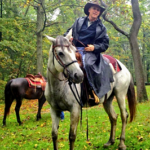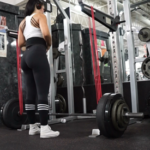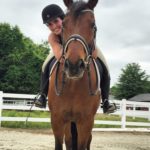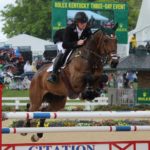In the summer of 2002 sporting art collectors gathered at Sladmore Gallery in London for the chance to view and perhaps, if they were lucky, to purchase one of 31 works by an artist considered by many to be the greatest in that field since Sir Alfred Munnings.
Heir to the artistic throne vacated when the revered Munnings died in 1944, Polish-born painter Andre Pater shares the twentieth-century master’s gift for breathing realistic life into his subjects. As affirmation to that genius, the London exhibit sold out to a huge, enthusiastic crowd in only 21 minutes.
Conceived by Lord Hartington, deputy chairman of Sotheby’s, to expand the artist’s market and to offer British collectors the opportunity to purchase a Pater watercolor or oil, the overseas show saw 11 works going to English buyers and the rest to Americans. Two sale toppers rang in at $75,000 each, a remarkable price for contemporary sporting art. But then Andre Pater is one remarkable man.
More than a century ago, William Wordsworth wrote, “With an eye made quiet by the power of harmony, and the deep power of joy, we see into the life of things.” And that’s exactly what this artist does. Through zen-like observation, he finds that essence, be it equine, canine, bovine, avian or human, and brings it to the canvas.
Compact and brightly skylit, Pater’s studio is rife with fat pastel nubbins, works in various states of progress, palettes of color shades, and fascinating props – a set of creamy, old-fashioned racing silks and black velvet cap cover hang here, a diminutive racing saddle leans against a stack of canvases there. On a centerpiece easel, a jockey rendered in vibrant pastels gazes, lost in thought, from a canvas begun as entertainment during the recent Lexington Ball.
Propped by a door, another painting draws the eye. Across a snowy field bright with sunrise, six foxhounds bound on scent, eager in the chase, each knowing its place in the pack, faces shining with obvious joy at doing what they love. Their movements are so precise, muscle action so real, you can almost feel them running, hear excited panting, smell damp fur.
The artist sips a perpetual cup of coffee to the vibrant strains of a tango. When he speaks of his art, as when he speaks of his family – wife Kashia and their children, son Bogdan (meaning “god-given” in Slavic), 12, and daughter Ole, 8 – a light sparks in crystal blue eyes that reflect a contagious enthusiasm.
“I love what I do,” he says. “I never count the hours I’m working in my studio. It’s pure joy. It’s fun. It makes me peaceful. It’s my enthusiasm that brings light to my paintings.”
And it’s the light in his paintings, in combination with expertly rendered detail, explains Greg Ladd, owner of Lexington-based, internationally acclaimed Cross Gate Gallery, that has made Pater’s work so highly sought after and its prices skyrocket. “His rise to prominence,” says Ladd, whose gallery is Pater’s sole representative, “has been nothing short of spectacular.”
At Sotheby’s 2001 sporting arts sale, a Pater pastel of three hounds, which Ladd had estimated would garner $15,000 to $20,000, brought $35,000, a record for a non-oil work by a living artist.
Usually an artist will cover several geographic markets, gallery-wise, but both men agree the union works well, professionally and personally. “It’s not just an art dealer-artist relationship, but a very personal one,” Pater explains. “We’re about the same age (49) and have children about the same age. We have the same way of seeing and thinking, the same values. That’s probably why we can work together without a contract.”
Whatever he paints, sells, says Ladd, sometimes even before a canvas is dry. “Andre doesn’t produce a lot of pictures because he works them to the point that everything’s right. It’s a classical approach to painting. Most artists will have some bad pictures out there somewhere. Andre doesn’t tend to. He makes sure of that.”
“He keeps me too busy,” Pater laughs, then adds: “In me he has a good horse he can run with. I’m very flexible and cooperative.”
And he’s living the American dream. Upon graduating summa cum laude in architecture from the Krakow Academy of Fine Arts, Pater came to New York on a temporary visa for an adventure before settling down to “real life.” But weeks later, martial law was declared in Poland and at his parents’ counsel, he never returned. Moving to Dallas, he worked as a designer for an architectural firm. But Poland has a strong Arabian horse breeding tradition and Pater had drawn and painted the breed for years. As a result, he was drawn to the Arabian horse world in Texas and soon returned to the work that always had fed his soul – painting.
“Painting was very personal for me,” Pater says. “It was a way for me to create my own world, to be in touch with myself. Imagination and creativity helped me create my own space.”
Once a 1984 show of his paintings in Reno, Nevada, sold completely out, he was established. Invited to Lexington while working an Arabian event in Louisville in the late 1980s, he took a wrong turn and drove out Paris Pike. “It was a beautiful fall Saturday,” he recalls. “The leaves were falling and people were riding horses on those farms. I thought I was in heaven!”
In 1988 he moved his family to the Bluegrass, where he’s been happily ensconced ever since,
shifting his palette from Arabians, Western horses and Texas polo scenes to those of the horse racing, foxhunting, sporting dogs and cattle predominant in Kentucky. When a painting of his landlord, Wimbledon Farm owner Hilary Boone, then Master of the Iroquois Hounds, caught Ladd’s eye, the two teamed up in 1991.
From Pater’s first one-man show at Cross Gate in 1992, he’s exhibited and sold well in horsey havens such as Aiken and Camden, South Carolina, Del Mar, California, and Saratoga Springs, New York. During the 1996 Summer Olympic Games, he hung a retrospective exhibit at the Polish Cultural Center in Atlanta and has won Best in Show at American Association of Equine Artists competitions at Morven Park in Leesburg, Virginia, and at the Kentucky Horse Park.
Sometimes branded a maverick, he admits, “I’m not a pleaser in painting but I do think about my clients during the process. Even if it is just my painting, I think about whoever will have this and enjoy it. I try to be upbeat and positive when I’m working, to be excited about the subject. To produce with this attitude takes awhile.”
His impressive clients include British Ambassador William S. Farish and Keeneland Race Course. Looking for a change from the horse paintings dominating its walls -“something dignified, distinctive and different,” says Ted Bassett, Keeneland Trustee and retired Chairman of the Board – the venerable Lexington track commissioned Pater in 1999 to create a series of jockeys depicting Keeneland’s top 25 stakes-winning owners over the past 60 years. The pastels have been a clubhouse hit.
Working from both life and photos, Pater paints in pastels and oils. Remarkably, he can infuse that trademark brilliant light in either medium.
Though his first area workspace was Thoroughbred owner Penny Chenery’s pool house with gorgeous farm views, Pater is currently in a tiny white cottage tucked into a complex of Central Kentucky tobacco warehouses. He dreams of a studio equipped with a kennel and small pasture where he can observe dogs, horses or cows close at hand.
“You have to know an animal to paint it,” he says. “Not posed or paying attention to you but when they’re comfortable, when they’re who they are. You have to be sharp enough to select those moments, the way a cow turns the head. Like with horses, they way they wave the tail.”
Pater has always had a passion for horses. As a child, he’d go with his mother or grandmother to village markets outside Krakow just to revel in the animals’ smell. Ever conservative, he chooses to capture horses, not racing, but “walking or trotting…half-movements…their presence. There are so many elements to consider – the tail, the head, the neck,” he says. “It’s how they express themselves. When you see horses running, it’s so fast and exaggerated. But before they go to the race and even after, there are so many elements.
“The horse as an animal is so physically finished as a beautiful composition,” he explains. “There’s nothing you can add or take from it. So any kind of approach to change it from a contemporary point of view doesn’t work. A horse must be a horse.”
Munnings, whose gracefully rendered works suggest he obviously concurred, provides inspiration for Pater, who’s amazed at how quickly his distinguished predecessor “made his paintings, at how clever he was, how wise he was.” Speed is not a forte of this twenty-first-century painter, so preparing for the London show had him under deadline pressure.
What with England being not only Munnings’ home turf but essentially the birthplace of sporting art, Pater says that with the London show, he “sort of stuck his head in the lion’s mouth.” But that lion merely smiled as Andre Pater garnered new collectors and successfully brought his work to an international audience.







